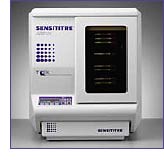| |
By Dr. Vincent LaBombardi, St. Vincent’s Hospital and Medical Center, New York City
 Methicillin-resistant S. aureus (MRSA) has been isolated in Methicillin-resistant S. aureus (MRSA) has been isolated in
the hospitalized patient since 1961. In many metropolitan
centers, MRSA is isolated more frequently than is methicillin-
susceptible S. aureus. MRSA has largely been a nosocomial problem. In the late 1980’s we saw a few outpatients, all of whom were IV drug users, from whom we isolated MRSA. Recently reports have appeared of patients,
who had not been recently hospitalized, who presented
with infections caused by MRSA. These community acquired
MRSA (CA-MRSA) have been reported in children
in day care, adolescents and young adults playing contact
sports including football and wrestling, among military
recruits and in a prison population (1-4). The majority of
these infections have been in skin and soft tissue. This organism
has also been described as a cause of necrotizing
pneumonia (5). This organism is apparently transmitted
person to person by close contact. We first noticed
these infections in our HIV+ population who presented
with rather aggressive cutaneous infections.
These organisms have been
reported worldwide and have
some common features that
separate them from nosocomially
acquired MRSA. These
organisms carry the mecA gene on a type IV staphylococcal
chromosomal cassette
(SCCmec type IV) (6). These organisms, in the large majority
of cases, also contain bicomponent genes that produce
Panton-Valentine leucocidin (PVL) (5,6). This is a virulence
factor that is responsible for the death of leukocytes
by causing the formation of pores in the cell membrane.
This factor is responsible for the rather aggressive
infections caused by these organisms. These CA-MRSA
appear to be more susceptible, than are nosocomial
MRSA, to non-beta lactam antibiotics. These organisms
can be susceptible to the quinolones, erythromycin, clindamycin,
trime thop rim/ sulfamethoxazole and the
tetracyclines. Since these are so virulent it is imperative that
infections caused by these organisms be treated quickly
and appropriately. We therefore need to perform susceptibility
tests and report the results on antibiotics that we
would normally not test or report for nosocomial MRSA.
Therefore, any specimen from a patient seen in any of our
clinics or the emergency room will be set up utilizing our
ARIS system with Sensititre gram-positive panels. Since the origin of an infection may
not be obvious to the laboratory,
we will also utilize this
test panel for any skin and
soft tissue specimen that
grows S. aureus. Currently we test and report oxacillin, penicillin,
vancomycin, erythromycin, clarithromycin, clindamycin, ciprofloxacin, tetracycline, SXT, and linezolid. Daptomycin will be tested and reported as soon as it is made available on this panel.
Of major concern is the possibility
that these CA-MRSA will
start to combine with nosocomial
strains and become
multi-drug resistant. It is imperative
that these isolates
be rapidly identified and appropriate
susceptibility tests
performed and reported.
|
 |



